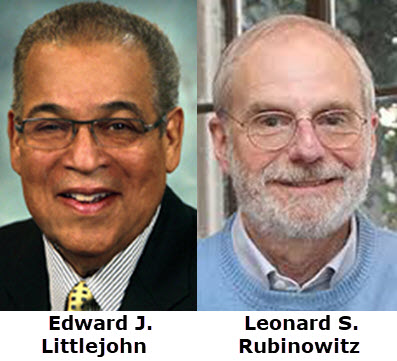Become a Patreon!
Abstract
Excerpted From: Edward J. Littlejohn and Leonard S. Rubinowitz, Black Enrollment in Law Schools: Forward to the Past?, 12 Thurgood Marshall Law Review 415 (Summer, 1987) (207 Footnotes) (Full Document through library)
 For a hundred years after the first Black student entered an American law school in 1868, Blacks were barely visible in law schools. Starting in the late 1960s, they made modest gains in enrollment. Black representation in law school peaked within a decade, and leveled off by the mid-1970s. This enrollment plateau continued until the mid-1980s, when signs appeared that Blacks might again become a rarity in law schools.
For a hundred years after the first Black student entered an American law school in 1868, Blacks were barely visible in law schools. Starting in the late 1960s, they made modest gains in enrollment. Black representation in law school peaked within a decade, and leveled off by the mid-1970s. This enrollment plateau continued until the mid-1980s, when signs appeared that Blacks might again become a rarity in law schools.
The statistics tell a story of vast underrepresentation of Blacks in law school compared to their percentage of the population over the last century and a quarter. At the highest point, Blacks constituted about five percent of law students, less than half their proportion of the population. These figures provoke many questions such as: why have Blacks constituted such a miniscule percentage of law students for so long; why were the increases in Black enrollment so modest; and why the growth in Black enrollment ceased so quickly, to be replaced by a leveling off, with intermittent declines. Finally, the numbers triggered speculation about the future of Blacks in law school and the legal profession.
During each of these periods, various forces in society interacted with factors in the law schools and the legal profession to affect Black enrollment. For the most part, intentional and overt racism was a key factor. However, occasionally the discrimination was subtle and covert. In earlier periods, racism prevented or limited Black enrollment. More recently, racial barriers continued to impede Black enrollment, while other racial initiatives helped to increase it.
In addition to intentional racial considerations, structural forces have had a very significant effect on Black enrollment. For example, financial considerations have constrained Blacks' ability to attend law school. Disparities in income and wealth between Blacks and whites have resulted in differential ability of the two groups to afford the costs of law school. Moreover, law schools' admission and graduation requirements have had an adverse impact on Black enrollment, even when that has not been their intent. For example, the increasing formal education requirements and the admission tests that have evolved during this century have had a racially disparate impact. The differential impact of societal and law schools' structural features often occurs because of the continuing effects of intentional racial discrimination.
Absent these structural and intentional racial factors in the larger society as well as in the law schools and the legal profession, Blacks presumably would have been represented in law school in proportion to their percentage of the population. Assuming there are no differences in education and income distribution among races, there is nothing to suggest that Blacks would attend law school at a different rate than other racial groups, if they had an unfettered choice to do so.
This article focuses on the barriers to Blacks' entry into law school from the nineteenth century, when law schools came into prominence, until the present. An examination of the structural and racial forces explains why so few Blacks entered, and a disproportionately few continue to enter law school. The article proceeds chronologically, considering enrollment patterns and explanations for them in three periods: 1) the century following the enrollment of the first Black law student in 1868; 2) the decade of substantial growth in Black enrollment; and 3) the leveling off in Black enrollment during the late 1970s and 1980s.
[. . .]
In the early 1970s, it was easy to predict that Black enrollment in law school would continue to increase indefinitely. Growth seemed to be a trend that was building momentum, but a few years later, it stopped. The leveling off was a reminder that structural and racial forces continued to hold sway. Interactions among society, law schools, and the legal profession still limited Black representation in law school.
Blacks remain vastly underrepresented in American law schools. Despite the modest gains of the decade of progress, the historic forces set limits on the magnitude and duration of growth in Black enrollment. The story remains, as it has always been, one of continuity more than change.
Underrepresentation is deeply ingrained, but it is not inevitable or pre-destined. Future decisions and actions will affect Black enrollment. The starting point is to assess the racial impact of past and present policies and practices, and to take them into account in making future decisions. For example, if law school administrators ask themselves, “what impact will this have on Black enrollment” when they think about admissions criteria, budgets, faculty appointments, placement programs, alumni relations, and the myriad other matters with which they deal daily, they will become aware that every decision they make can have such an effect. The actions they take in light of their racial impact analysis will help determine the future of Black enrollment.
Edward J. Littlejohn, Professor, Wayne State University Law School.
Leonard S. Rubinowitz, Professor of Law and Research Faculty, Center for Urban Affairs and Policy Research, Northwestern University.
Become a Patreon!


